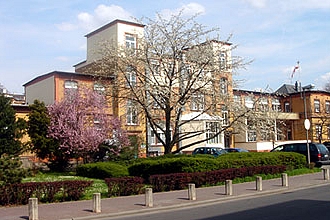University of Frankfurt
Frankfurt, Germany
Fellowship Director: Robert Sader
The department offers the complete operative and conservative health care spectrum of oral and maxillofacial surgery as well as plastic and reconstructive facial surgery. It is equipped with two operating rooms, an additional outpatient surgical unit, and a laser therapy unit. In addition to adult inpatients (23 beds), children are accommodated on a separate ward in the pediatric department. Traumatized patients are treated by an interdisciplinary team which also includes members of the Department of Traumatology. At present, 14 surgeons belong to the department’s staff: the head of the department, 3 assistant medical directors, 7 double-degree residents, and 3 dentists pursuing continuing education in oral surgery.
The department offers special consultations for patients suffering from cleft lip and palate, craniofacial malformation, dysgnathia, cancer of the oral and maxillofacial area, fractures of the facial skeleton, and diseases of the temporomandibular joint, and for patients requiring dental implantology. Interdisciplinary consultations are held in cooperation with the policlinic for orthodontics (dysgnathia), the policlinic for prosthodontics (masticatory rehabilitation), the Department of Dermatology (diseases of the oral mucosa) and the Department of Neurosurgery (subcranial and craniofacial surgery).
The department maintains a 24-hour oral and maxillofacial emergency service.
Focuses of patient treatment
Cleft Lip and Palate Center
The university medical center is the biggest European treatment center for patients with cleft lip and cleft palate. It is the first medical center in Germany where even complete clefts are closed in just one operation. Patients receive interdisciplinary care with an individual approach that pays special attention to their bio-psychosocial factors.
Therapy of craniofacial malformation
Due to their complexity, these operations are planned using three-dimensional technology and are carried out in close cooperation with the Department of Neurosurgery. This enables the precise performance of skeletal remodeling and the fitting of transplants or implants. Due to the use of 3D-technology, functional and aesthetic outcomes can be improved and operation times can be reduced.
Operations for dysgnathia
Serious anomalies of form and position of the jaws that cannot be treated with orthodontics alone are planned with the aid of computer modeling. During the operation, the temporomandibular joints are exactly positioned under sonographic control. For osteofixation the most up-to-date resorbable osteosynthesis systems are used.
Cancer surgery
Treatment of tumors of the facial region and the oral cavity, including full functional and aesthetic rehabilitation, is accomplished through a common multimodal concept followed by our department and the departments of neuroradiology, radiotherapy, diagnostic radiology and nuclear medicine. Of special interest is the creation of an individualized concept addressing the patient’s speaking and swallowing functions, which greatly influence the patient’s quality of life.
Traumatology
Treatment of injuries of the facial skeleton is dominated by modern methods of osteosynthesis and the use of the latest materials. For special indications, minimally invasive techniques for treatment of mandibular fractures are used.
Local plastic-reconstructive and aesthetic-based surgery
For reconstructive surgery of large cancer- or trauma-based defects of the bone or the facial soft tissue, modern microsurgical techniques for aesthetic and functional rehabilitation are used. Customized individual transplants and implants are manufactured using 3D-methods and the latest materials and technologies.
Dentoalveolar surgery and maxillofacial implantology
Modern techniques in dentoalveolar surgery and intra- and extraoral laser surgery are also used. In particular, the use of new types of implants with coated surfaces permits application even for complicated circumstances such as maxillary and mandibular atrophy.
Research
Besides expanding its medical care and teaching, the department is working to establish an efficient research infrastructure as its third column. The existing spectrum of research, based on cancer cell biology, angiogenesis, surgery of malformations and the use of new resorbable materials, has been markedly extended to include focal points of the medical faculty (immunology) and of the university (e-learning). Another important development is increased cooperation with the nearby technical university of Darmstadt and the university medical center in Mainz for the domain of applied material science and with the European technical college Fresenius in Idstein in the area of cognitive speech science. Newly raised funds, together with third-party (industrial) funding brought in by the new medical director, led to the creation of 1.5 new workplaces in just the last year.
The main focuses of research are:
- Surgery of cleft lip and palate—new operative concepts and techniques that incorporate bio-psychomotor parameters and parameters of speech function
- Oncology—molecular biological parameters in multimodal cancer therapy, rehabilitation-oriented treatment concepts
- Stem-cell-based angiogenesis—intraoral wound healing, effect of salivary factors
- Laser-aided procedures—laser treatment of human hard tissue (bone, cartilage, teeth), photodynamic therapy of periimplantitis, holographic 3D imaging
- Applied material science—manufacturing of bioactive surfaces, development of new “intelligent” and resorbable materials, use of novel hybrid implants
- Tissue engineering of bone—angiogenesis, interaction on interfaces “biological tissue–man-made material,” rapid prototyping of scaffolds
- Head & neck sonography—3D diagnostics, interventional ultrasound, acoustic grid microscopy
- Computer-assisted surgery—mathematical modeling and simulation, 3D visualization, virtual and augmented reality for intraoperative navigation
- Scientific networking—development and use of new technologies for telemedicine and e-Learning appliance
For further information contact:
Prof. Dr. Dr. Dr. Robert Sader
Dept. of Oral, Cranio-Maxillofacial and Plastic Facial Surgery
Medical Center Frankfurt University
Theodor-Stern-Kai 7
D – 60590 Frankfurt am Main
Germany
Phone: +49 (69) 6301 5643
Fax: + 49 (69) 6301 5644
E-Mail: R.Sader@em.uni-frankfurt.de
IBRA Administration Office
Hochbergerstrasse 60E
CH-4057 Basel, Switzerland
© 2019 IBRA
IBRA Newsletter
IBRA Administration Office | Hochbergerstrasse 60E | CH-4057 Basel, Switzerland | Phone: +41 (0)61 319 05 05 | info@ibra.ch | www.ibra.ch




